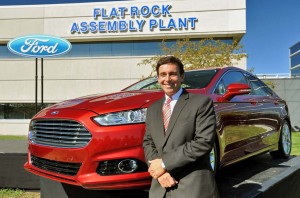By 2015, Ford plants around the world will be able to produce 25% more vehicles and their derivatives than they could turn out in 2011, company officials said Monday.
Increasing the range of models rolling off a single assembly line should help the maker better balance production and demand, said Mark Field, Ford president of the Americas, during an appearance at the maker’s plant in the southern suburbs of Detroit.
Long known as AutoAlliance, that plant was operated as part of a joint venture with Mazda Motors. The Japanese maker built its last Mazda6 sedan there last month, however, and Ford has now taken full control of the facility, renaming it the Flat Rock Assembly Plant – a reference to the town where it is base.
“The new Flat Rock Assembly Plant symbolizes the growth driven by our One Ford plan,” said Fields, adding Ford will be adding a second shift at the Flat Rock plant in the first half of 2013.
“Ford continues investing in people, products and plants to deliver the head-turning, fuel-efficient, fun-to-drive vehicles people really want, including the all-new Fusion,” said Fields.
In addition to adding 1,200 new hourly jobs tied to Fusion production, Ford also is investing $555 million to build a state-of-the-art, fully flexible body shop capable of producing multiple “top hats,” or body styles on common platforms. That’s a relatively easy way to add more product while reducing development costs. It also should allow the maker to boost production of one variant when another begins to lose market momentum.
With each new major plant program, Ford is significantly increasing the flexibility of its equipment and facilities to build multiple vehicles at one location.
“By fully incorporating Flat Rock Assembly into our manufacturing system, we are able to take advantage of internal efficiencies that will streamline our ability to produce vehicles,” said Jim Tetreault, Ford vice president of North America Manufacturing. “This is critical as we increase our capacity to meet growing customer demand for our products.”
By 2015, Ford will be able to produce 25% more derivatives per plant versus 2011 on a global basis, Treault said.
Previously known as AutoAlliance International, Flat Rock Assembly is now under the full management control of Ford. The plant continues to be owned by a joint venture that is split 50/50 between Ford and Mazda Motor Corp., however.
Opened in 1987 as Mazda Motor Manufacturing USA, the plant in Flat Rock first produced the Mazda MX-6. In 1992, Ford purchased a 50% share in the plant and it was renamed AutoAlliance International. Over the years, the plant produced the Mazda 626, Mazda6, Mercury Cougar and Ford Probe. Mustang production was shifted to the plant in 2005.
Introduced six years ago, Fusion is part of the fastest-growing segment in the U.S. this year – midsize sedans. Ford expects the midsize sedan segment, which totaled 2.1 million vehicles in 2011, to continue growing.
Fusion’s share of the segment has doubled to 12% since it was introduced, and the car has set sales records in five of the first seven months of this year. Industry analysts expect that to grow with the addition of an all-new version of the Fusion scheduled to debut in 2013 – but they also caution that the midsize market is facing more competition than it has in years.
The Fusion will go up against an array of domestic and import alternatives including the 2013 Chevrolet Malibu, Nissan Altima and Honda Accord as well as the segment’s sales leader the Toyota Camry. So having the flexibility to shift between models could prove critical.

